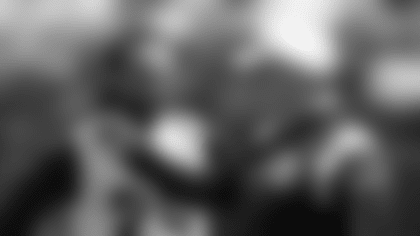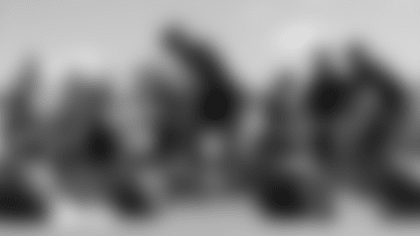In the Eagles' long and colorful history, there never has been another season quite like 1943. That was the year of the Steagles.
For one season, the Eagles and the Pittsburgh Steelers merged to form one team. It became known as the Steagles and despite the craziness involved, the team actually finished the season with a winning record at 5-4-1. It was the first time the Eagles had seen the other side of .500 since their founding in 1933.
This season marks the 75th anniversary of the Steagles but no big celebrations are planned. It is just a footnote in the history of the two franchises but it is a chapter in their respective histories that says a lot about what was happening in the world at the time.
"It was done out of necessity," Steelers owner Art Rooney Sr. said in a 1974 interview. "The war was going on and most of the players were in the service. A lot of the coaches, too. We didn't have the manpower to field a team and neither did the Eagles but we thought we could make it work if we pooled our resources."

It was quite a challenge. The team divided its home games between Philadelphia's Shibe Park and Pittsburgh's Forbes Field. Practices were irregular at best since the players were divided between the two cities and most had defense jobs working in shipyards or factories. The government insisted on the players putting in 40 hours a week as part of the war effort.
The biggest issue was coaching. Rooney and Bert Bell, his Philadelphia counterpart, made the two head coaches – Greasy Neale of the Eagles and Walt Kiesling of the Steelers – co-coaches for that season. Anyone who knew the two men knew that arrangement couldn't possibly go smoothly and it didn't.
"I thought Greasy was the most stubborn man I ever met until I met Kiesling," said Frank "Bucko" Kilroy, an Eagles tackle who played for the Steagles. "They didn't get along at all. The idea was for Greasy to coach the offense and Kiesling to coach the defense, but they spent most of the time fighting with each other. It was actually kind of funny to watch."
"Greasy would put in a play and Kiesling would say, 'That'll never work,'" said Vic Sears, an All-Pro lineman with the Eagles who became a Steagle. "Greasy would tell him off and Kiesling would come back at him and we'd be there wondering when we'd get back to work. It was the craziest thing I ever saw in all my years of football, but we finished with a winning record. Don't ask me how."
"It sounds like we had a big advantage, putting two teams together as one," said Eagles Hall of Fame tackle Al Wistert, who was a rookie on that team. "But all it meant was we had twice as many lousy players. Look at the teams. The Eagles had never had a winning season and the Steelers were almost as bad."
The Steelers had their first winning season (7-4) the previous year but their best player, halfback Bill Dudley, a future Hall of Famer, was flying a bomber in the Pacific with the Army Air Corps. Eagles quarterback Tommy Thompson was serving with the Army in Europe. Dozens of other players were off fighting the war. The only NFL veterans who were still on the field were those who failed their military physicals or overage players like end Bill Hewitt who came out of retirement to play for the Steagles.

Hewitt, a future Hall of Famer, gained fame by playing without a helmet during his time with the Chicago Bears and Eagles prior to his retirement in 1939. By the time he returned in 1943 with the Steagles, the NFL had passed a rule requiring all players to wear helmets so Hewitt played that season in a headgear although he complained every day when he fastened his chin strap. He was the highest-paid player on the team at $400 per game.
"I still remember the first day of practice," said Wistert, who later became captain of the Eagles' championship teams in 1948 and '49. "I walked on the field and there was Bill Hewitt smoking a cigarette. I couldn't believe it. Bill was a legend at (the University of) Michigan. He was part of the reason I went there. To see him smoking a cigarette on this rundown field with trash and broken glass strewn around, it was such a letdown. I thought, 'This is pro football?'"
In truth, it was a facsimile of pro football, the best the two teams could do under the circumstances. The other teams were able to make a go of it without merging but even the best teams such as Chicago and Green Bay were a patchwork of military rejects (4-Fs) and recycled veterans. The Bears talked the legendary Bronko Nagurski out of a five-year retirement and he helped lead Chicago to the championship.
The league did what it could to help the Steagles. For example, it convinced Washington to sell Roy Zimmerman to the Steagles for a bargain price so the team would have a decent quarterback. Zimmerman was Sammy Baugh's backup in Washington which meant he wasn't going to play much there so the league figured it would be to everyone's benefit if he went to the Steagles.
Zimmerman didn't have a very good year – he completed just 34 percent of his pass attempts with nine touchdowns and 17 interceptions – and he wound up splitting time with a little left-handed rookie from Brooklyn College named Allie Sherman who later would become head coach of the New York Giants.
The Steagles got off to a shockingly fast start winning their first two games – 17-0 over the Brooklyn Dodgers and 28-14 over the Giants. In the opener, the Steagles held the Dodgers to -33 yards rushing. It is still the only game in franchise history that the Eagles – or in this case, Steagles – held an opponent to negative yardage.
Reality set in the following week when the Steagles faced the Bears in Chicago and lost, 48-21. They lost again the next week to the Giants, 42-14. They were able to tread water the rest of the season, hovering around .500. Their best player was halfback Jack Hinkle who rushed for 132 yards on 13 carries in a 27-14 win over Washington on November 28.
Hinkle finished the season with 571 yards but he lost the rushing title by 1 yard to Bill Paschal of the Giants. It was later claimed Hinkle should have finished ahead of Paschal but he was cheated out of a 37-yard run when the official scorer credited the yardage to another player. How could that happen, you ask? It was a rainy day, the uniforms were muddy, so no one could see the numbers. It seems fitting somehow.
The next year the Eagles decided to go their own way. Most people believe Neale refused to spend another year working with Kiesling. Whatever the reason, the Eagles ended the partnership, used their top draft pick on halfback Steve Van Buren and surged to a 7-1-2 record in 1944. The Steelers merged with the Chicago Cardinals, forming a team that became known as the Car-Pitts (pronounced Carpets) because it didn't win a game (0-10).
"That was the worst team ever," Rooney said. "The Steagles were world beaters compared to that team."
An award-winning writer and producer, Ray Didinger was inducted into the Pro Football Hall of Fame in 1995. He has also won six Emmy Awards for his work as a writer and producer at NFL Films. The five-time Pennsylvania Sportswriter of the Year is a writer and analyst for NBC Sports Philadelphia. Didinger will provide Eagles fans a unique historical perspective on the team throughout the year for PhiladelphiaEagles.com. You can read all of hisEagles History columns here.He is also the author ofThe Eagles Encyclopedia: Champions Edition which is in bookstores now.














